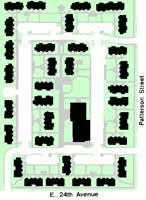Introduction

This case study focuses on the subjective perception of acoustic comfort, specifically regarding the acoustic transmission between apartments through the floor assembly. This research project is focused on the Spencer View Apartments (24th and Patterson) in Eugene, Oregon, which is a multi-family housing complex. For the most part, these apartments seem to have been constructed with the intention of providing student housing that offers good quality for the price (both of initial construction and of monthly rent). This study developed after hearing first-hand the degree to which various sounds migrated from the upstairs apartments into the ground-floor apartments. We began to wonder about the adequacy of the acoustic isolation. Did these apartments meet code? Certainly they must, we assumed, as they are barely 5 years old (built in 1996) If this were indeed the case, then perhaps we are hearing a failure not of the apartment's construction per se, but instead a fundamental deficit in the acoustic specifications in the building code.
The Apartments
 Because of the scale of the complex and its status as a University-built complex, this development was able to provide some degree of an "economy of scale" in that the overall quality of the development is quite good, especially in
contrast to comparable units in the area. There are a total of 272 apartment units in 32 buildings. The buildings are 2-story light wood frame construction. Each unit has 2-3 bedrooms and ranges between 600 - 800 sq.ft. The wall finishes are high-gloss paint over textured gypsum board. The floors are commercial-grade, low-nap carpet. The second floor apartments contain carpet over a plywood deck. On the ground floor, the carpet is over a concrete slab. Because of the scale of the complex and its status as a University-built complex, this development was able to provide some degree of an "economy of scale" in that the overall quality of the development is quite good, especially in
contrast to comparable units in the area. There are a total of 272 apartment units in 32 buildings. The buildings are 2-story light wood frame construction. Each unit has 2-3 bedrooms and ranges between 600 - 800 sq.ft. The wall finishes are high-gloss paint over textured gypsum board. The floors are commercial-grade, low-nap carpet. The second floor apartments contain carpet over a plywood deck. On the ground floor, the carpet is over a concrete slab.
In our initial site visits, we observed quite strikingly that the ceiling appeared to provide a level of acoustic performance far below our expectation of minimal acoustic performance for multi-family housing, even given the "quasi-dormitory" status of the complex. However, the achieved level of acoustic isolation is definitely not above average. The frequency and magnitude with which we, as ersatz ground-floor tenants, could hear sounds originating in the apartment upstairs was quite high. Our research into the construction documents shows that steps were taken to provide a minimum level of acoustic separation between apartments. However, the experience of this floor assembly that does in fact meet acoustic codes seems to be far from satisfactory, begging the questions: is this experience shared among tenants of Spencer View? If so, are the commonly accepted acoustic standards sufficient?
Abstract
 In order to test the human experience of sound transmission in multi-family housing, we distributed a survey to all of the residents of the Spencer View apartments. This survey was structured to provide data for comparison between impact and airborne sound sources, and the
different experiences between the upstairs and downstairs units. We correlated this subjective data against calculations of the acoustic performance of the existing floor assembly. Through the calculations, we found that the apartments are constructed so that they probably meet code minimally. However, the survey data that we received back shows a high level of awareness of and annoyance by sounds passing through the floor assembly between apartments. Most striking (no pun intended) was the degree to which people living downstairs heard impact sounds from upstairs. In this regard, the experience of the upstairs and downstairs apartments were far from similar. This exploration of acoustic isolation in multi-family housing provides the opportunity to study the tenants' perceived degree of contentment towards the acoustic environment. In order to test the human experience of sound transmission in multi-family housing, we distributed a survey to all of the residents of the Spencer View apartments. This survey was structured to provide data for comparison between impact and airborne sound sources, and the
different experiences between the upstairs and downstairs units. We correlated this subjective data against calculations of the acoustic performance of the existing floor assembly. Through the calculations, we found that the apartments are constructed so that they probably meet code minimally. However, the survey data that we received back shows a high level of awareness of and annoyance by sounds passing through the floor assembly between apartments. Most striking (no pun intended) was the degree to which people living downstairs heard impact sounds from upstairs. In this regard, the experience of the upstairs and downstairs apartments were far from similar. This exploration of acoustic isolation in multi-family housing provides the opportunity to study the tenants' perceived degree of contentment towards the acoustic environment.
 
|